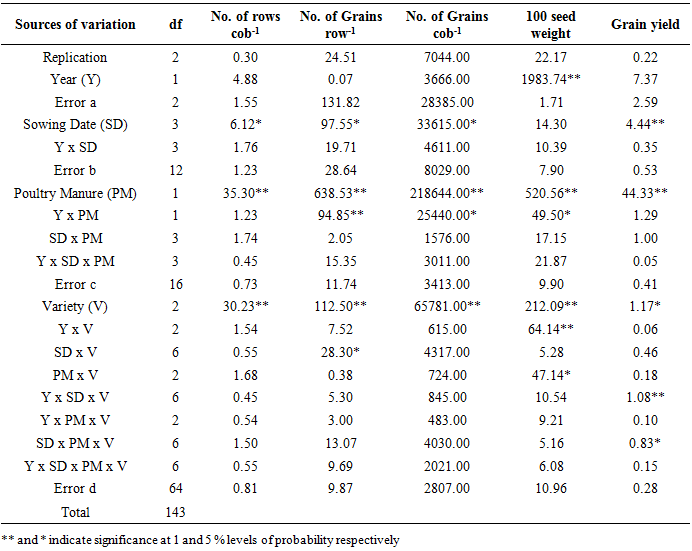-
Paper Information
- Paper Submission
-
Journal Information
- About This Journal
- Editorial Board
- Current Issue
- Archive
- Author Guidelines
- Contact Us
International Journal of Agriculture and Forestry
p-ISSN: 2165-882X e-ISSN: 2165-8846
2020; 10(1): 11-18
doi:10.5923/j.ijaf.20201001.02

Adaptation to Delayed Onset of Rainfall for Maize Production in a Humid Tropical Environment
Ndubuisi C. Adikuru1, Iheanyi J. Ogoke1, Izuchukwu I. Ibeawuchi1, Abraham A. Ngwuta1, Tessy U. Madu2
1Department of Crop Science and Technology, Federal University of Technology, Owerri Imo State, Nigeria
2National Root Crops Research Institute, Umudike Umuahia, Abia State, Nigeria
Correspondence to: Ndubuisi C. Adikuru, Department of Crop Science and Technology, Federal University of Technology, Owerri Imo State, Nigeria.
| Email: |  |
Copyright © 2020 The Author(s). Published by Scientific & Academic Publishing.
This work is licensed under the Creative Commons Attribution International License (CC BY).
http://creativecommons.org/licenses/by/4.0/

Delayed onset of rainfall threatens food security in Nigeria because it shortens the growing season and constrains farmers to delay planting. This study was conducted in 2009 and 2010 to assess the impact of delayed onset of rainfall on maize production and determine adaptation strategies in the rainforest agroecology of Nigeria. As part of the study, analysis of rainfall trend in the location was performed using 30 years (1978 – 2007) data. Four sowing dates (February 28, March 15, March 30 and April 14), two poultry manure rates (0 and 10 tons ha-1) and three maize varieties (TZE COMP3C3, TZL COMP4C3 and OKA AWAKA) were combined as a split-split plot and laid out in randomized complete block design with three replications. The result showed that delayed onset of rainfall in the study area is the consequence of a shift in the rainfall pattern within the months of February and March. Analysis also revealed a declining trend in average annual rainfall and rain days. The resulting moisture stress was responsible for 22.6% reduction in grain yield when maize was planted on February 28 compared to March 30. However, application of poultry manure cushioned the effect of moisture stress and improved grain yield by 27.0 to 59.7% across sowing dates. Appropriate time of planting, poultry manure application and varietal selection were found effective for adaptation to delayed onset of rainfall in the humid region of Nigeria.
Keywords: Delayed onset, Maize, Moisture stress, Rainfall, Rainforest, Sowing date
Cite this paper: Ndubuisi C. Adikuru, Iheanyi J. Ogoke, Izuchukwu I. Ibeawuchi, Abraham A. Ngwuta, Tessy U. Madu, Adaptation to Delayed Onset of Rainfall for Maize Production in a Humid Tropical Environment, International Journal of Agriculture and Forestry, Vol. 10 No. 1, 2020, pp. 11-18. doi: 10.5923/j.ijaf.20201001.02.
Article Outline
1. Introduction
- Food production systems in various countries are threatened by climate variability and change. According to the Intergovernmental Panel on Climate change (IPCC) [1], climate change refers to a change in the state of the climate that can be identified (e.g using statistical tests) by changes in mean and/or the variability of its properties and that persists for an extended period, typically decades or longer. Climate variability refers to the climatic parameter of a region varying from its long-term mean [2]. Variability is therefore an inherent characteristic of climate while climate change is the end product of a changing climate [3]. Most studies on the impact of climate change in Nigeria are based on rainfall and temperature which are the climate variables most critical to measure with regard to food systems [4]. Rainfall however, is the most important element of climate change in Nigeria [5]. Among some weather parameters studied from 1971 to 2003, rainfall exhibited the highest variability [6]. Several studies across the rainforest zone of Nigeria have shown a changing rainfall pattern [7-11]. The changing pattern of rainfall manifests as rainfall variability, and may be evaluated by measuring onset, cessation and amounts of annual rainfall. Below 6ºN of the equator in Nigeria, [12] noted that onset of rains was in late February and cessation in December. A quarter of a century after, analysis of rainfall patterns in Nigeria showed that rains hardly established until late March and ended in November [10]. Furthermore, while [12] reported 360 rainy days per year in the Niger Delta coastal area, [10] reported that average for the period of study (1970-2002) stood at 280 days, which implied a 22% drop in rainy days. These corroborate the result of analysis of rainfall data in Nigeria over a period of 30 years (1961-1990) by scientists at International Institute for Tropical Agriculture in Ibadan Nigeria. The analysis revealed that the greatest changes occurred with regard to the onset of the rainy season, and the extent of early rainfall. Thus the delayed onset of rains had tended to shorten the growing season overall by about a month and there were fewer wet days per season, although the intensities of rainfall were greater [13].Delayed onset of rain constrains farmers to delay planting (until the rain is established) because it leads to moisture deficit, high solar radiation, reduced humidity and high evapotranspiration thereby creating moisture stress (drought) condition during the early season. This scenario threatens food security in Nigeria and particularly southern Nigeria where crop production is mainly rainfed [14].Consumption of maize, which is the principal cereal cultivated in southern Nigeria [15,16] is projected to increase by 50% globally and 93% in sub-Saharan Africa from 1995-2020 [17]. In southern Nigeria, maize could be planted twice in a year. The first, known as early maize, is planted with the onset of the early rains from March/April to June/early July (early planting season). The second, known as late maize is planted from late July/August to late October/early November (late planting season). However, most farmers prefer the early planting season [18]. According to [19] maize yields decline with lateness of planting, after an optimum time, usually the start of the rains. Responses of varieties to other inputs are also dependent upon planting time. Maize yield losses may, therefore, be inevitable due to delayed onset of rainfall because it introduces sharp variations in soil moisture and thermal conditions in the early part of the rainy season (early vegetative stage of maize growth) thereby imposing different degrees of drought stress on the crop [20]. [21] predicted a maize yield reduction of 10% in Africa and Latin America by 2055, while recognizing the possibility of increases in some areas. It is, therefore, necessary to assess the impacts of delayed onset of rainfall in the rainforest zone of Nigeria with a view to determine appropriate adaptation strategies for improvement of maize productivity.
2. Materials and Methods
2.1. Description of Experimental Site
- The study was conducted at the Teaching and Research Farm, School of Agriculture and Agricultural Technology, Federal University of Technology, Owerri in 2009 and 2010 (two seasons). Owerri lies between latitudes 5° 20’N and 5° 27’N and longitudes 7° 00’E and 7° 07’E in the rainforest ecological zone of Nigeria [22]. The location has mean annual rainfall of 2500 mm and minimum and maximum annual ambient temperature of 20°C and 32°C respectively [23]. Owerri is located in southeastern Nigeria where the soils were formed from coastal plain sands [24,25] and are classified as sandy ultisols [26]. The rainfall and number of rain days for Owerri in 2009 and 2010 were obtained from the Agrometeorology unit of the Department of Agricultural Engineering, Imo state Ministry of Agriculture, Owerri. Rainfall data for 30 years (1978 – 2007) were also retrieved and used to study rainfall trend at the location.
2.2. Treatments and Experimental Design
- The treatments comprised four sowing dates (February 28, March 15, March 30 and April 14), two poultry manure rates (0 and 10 tons per hectare) and three maize varieties (TZE COMP3C3, TZL COMP4C3 and OKA AWAKA). The sowing dates were based on expected onset of rainfall (March 10-20) as predicted by the Nigerian Meteorological Agency [27]. For the purpose of this study therefore, March 15 (mean of March 10 and 20) was determined as the onset of rainfall. Two of the maize varieties used in the experiment, TZE COMP3C3 (early maturing) and TZL COMP4C3 (late maturing) were obtained from International Institute for Tropical Agriculture in Ibadan Nigeria. The third variety (OKA AWAKA) is a landrace from Awaka in Owerri North local government area of Imo state, Nigeria. The experiment was laid out as a split-split plot in randomized complete block design. There were a total of 24 treatment combinations which were replicated three times. While sowing date constituted the main plot, poultry manure was the sub-plot treatment and maize varieties the sub-subplot. Each main plot measured 8.5 x 11.0 m2, subplots measured 3.75 x 11.0 m2 and sub-subplots measured 3.75 x 3.0 m2. Two maize seeds were sown per hill at a spacing of 0.75 x 0.25 m and seedlings were thinned to one per hill at three weeks after planting (WAP) giving a population of 53,333 plants ha-1.
2.3. Data Collection and Analysis
- The number of grain rows per cob, number of grains per row, number of grains per cob (kernel number), weight of hundred seeds and grain yield were all determined in this study after maize cobs from the central row have been harvested at 15 WAP. Thus, the harvest dates in accordance with the sowing dates were June 13, June 28, July13 and July 28. All data were analysed according to analysis of variance procedures for a split-split plot design using Genstat 7.2 (Discovery Edition 3). Means were separated using the least significant difference.
3. Results and Discussion
3.1. Delayed Onset as Consequence of Shift in Rainfall Pattern
- The annual rainfall totals for 2009 and 2010 were 2732.9 mm and 2114.5 mm which corresponded to a monthly average of 227.7 mm and 176.2 mm, respectively (Figure 1a). Average monthly rainfall for the period of the experiment (February – August) in 2009 and 2010 were 259.5 mm and 170.3 mm, respectively. In 2009 and 2010, the location experienced 123 and 100 rain days, respectively (Figure 1b).
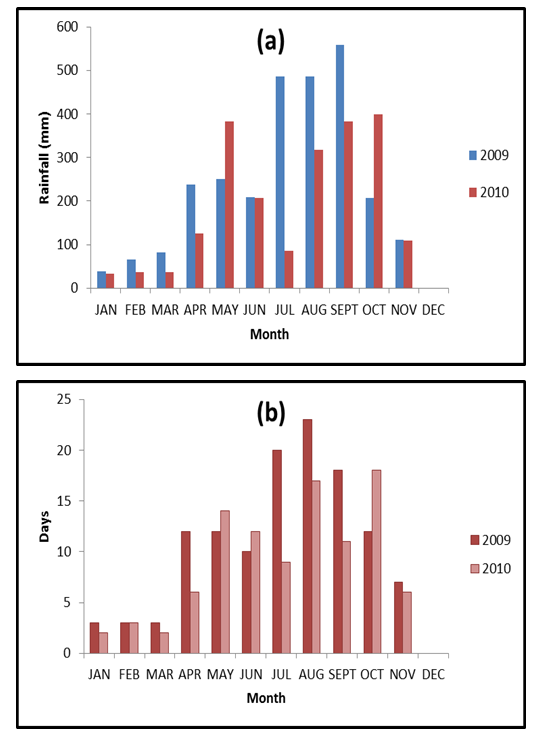 | Figure 1. Amount of Rainfall in mm (a) and Number of Rain Days (b) at Owerri in 2009 and 2010 |
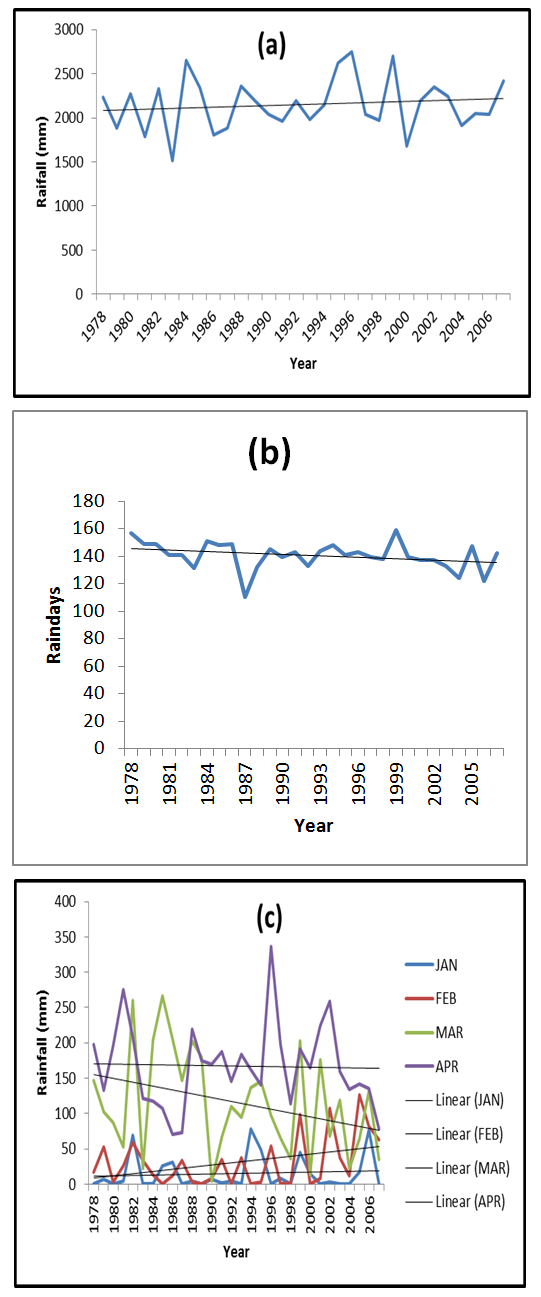 | Figure 2. Annual Rainfall Totals (mm)(a), Number of Rain Days (b) and Pattern of Rainfall for January to April (c) for Thirty Years (1978 - 2007) in The Study Area |
3.2. Effect of Season on Maize Yield and Yield Components
- Analysis of variance results revealed significant differences in the 100 seed weight of maize (p= 0.001) between the grain yields from 2009 and 2010 cropping. Other parameters were not significantly affected by year of cropping (Table 1). This is suggestive of inter-annual variability in climatic condition in the study location [6]. According to [30] maize development was significantly affected by climatic factors (mainly temperature) in the rainforest agroecology. Between the years, 2010 was generally drier than 2009 as a result of lower rainfall and rain days (Figure 1) thereby indicating difference in the level of moisture availability. The implication is the existence of uncertainty in climatic variables from year to year due to changing rainfall pattern. Therefore performance of maize in the location will depend on the prevailing climatic condition in a season. However, the difference in moisture availability between the years was not sufficient to cause serious differences in the performance of maize. Hence, the effect of year x variety interaction was only significant (p= 0.004) on the 100 seed weight (Table 1). Nevertheless, it will be of immense benefit to conduct simulation studies on the trend of rainfall and other climatic parameters in order to predict the future effect of moisture deficit on crop production in the area. This will serve as early warning mechanism (in case of a worsening situation) and provide relevant information to drive agricultural policy and crop improvement programmes.
|
3.3. Effect of Moisture Stress on Maize Yield and Yield Components
- Sowing date had significant effects on number of rows cob-1 (p=0.018), number of grains row-1 (p=0.053), number of grains cob-1 (p= 0.03) and highly significant effect (p=0.003) on grain yield (Table 1). These effects are attributed to variation in the moisture available to the crop at the different time of planting. In the rainforest region, evapotranspiration increases as onset of rainfall is delayed and temperature maintains an increasing trend [11]. This is more often the situation between February and March when solar radiation receipts increase [31]. During this period, these humid areas are prone to spells of soil moisture deficit [28]. Therefore, maize planted in February encountered a spell of moisture stress in March in confirmation of the trend of monthly rainfall totals earlier reported (Figure 2c). This pattern was the same in the two years, showing that the effect of variation in moisture availability due to time of planting was not dependent on season. Hence, the effect of year x sowing date interaction was not significant on all parameters. The greatest grain yield (3.37 tons ha-1) was obtained when maize was planted on March 30 while the lowest (2.61 tons ha-1) was obtained when maize was planted on February 28 (Table 2). Grain yield from maize planted on March 30 was significantly greater than maize planted on February 28 and April 14 by 29.1 and 20.4 % respectively. On the other hand, maize planted on March 15 had 22.6% more grain yield than maize planted on February 28. Moisture stress was responsible for 6.0, 14.0, and 19.0% reduction in number of rows cob-1, number of grains row-1 and number of grains cob-1 respectively when maize was planted on February 28 compared to March 30. Consequently, grain yield reduced by 22.6% due to moisture stress. It has been reported that between 17 and 81% reduction in maize grain yield is due to moisture stress [32], as a result of the effect of reduction in kernel number brought about by asynchronous flower development [33-35]. When maize was planted on March 15 however, moisture stress reduced number of rows cob-1, number of grains row-1 and number of grains cob-1 by 7.1, 13.1 and 18.7% respectively, and caused a 5.0 % reduction in grain yield compared to planting on March 30. Hence, the severity of moisture stress effect depended on the time of planting [19]. Generally, maize planted on March 30 produced significantly greater grain yield and more grains cob-1 (kernel number) compared to other planting dates. Considering that maize grain yield is closely associated with kernel number [36,37], planting on March 30 (which is close to the 9th April predicted onset of rains for Owerri [38]) appears to be the optimum sowing date in this study.
 | Table 2. Effect of Sowing Date and Poultry Manure on Yield and Yield Components of Maize |
3.4. Reduced Effect of Moisture Stress on Maize in Response to Poultry Manure
- The effect of poultry manure application was highly significant (p = 0.001) on all the parameters (Table 1). The application of 10 tons ha-1 of poultry manure significantly increased number of rows cob-1, 100 seed weight, number of grains row-1, number of grains cob-1 and grain yield by 7.9, 18.1, 18.9, 27.8 and 45.5% respectively (Table 2). This shows the improvement of maize growth and development in response to application of poultry manure. The capacity of poultry manure to improve crop growth through the enhancement of soil organic matter and supply of exchangeable cations has been well reported [39-41]. Improvement of maize yield and yield components in response to poultry manure application was independent of sowing date. Thus, sowing date x poultry manure interaction did not affect the parameters significantly. This indicates that while poultry manure enhances maize performance when moisture is adequate it also has the capacity to cushion the effect of moisture stress on maize growth and development. This reduction in the effect of moisture stress on maize may be due to improvement in the capacity of soil to hold moisture and improvement in other soil physical properties in response to poultry manure [42]. [43] have reported that improved soil moisture which is associated with poultry manure is attributable to the mulching effect of organic matter and improved moisture retention. The response of maize varieties to poultry manure application did not differ significantly in all the parameters except 100 seed weight (p = 0.018) (Table 1). This shows that the effect of poultry manure does not depend on the variety of maize. However, the grain yield of maize varieties in response to poultry manure application differed significantly (p = 0.012) across the sowing dates (Figure 3). This agrees with the report that the response of maize varieties to inputs is dependent on time of planting [19]. The effect of year x poultry manure interaction was highly significant on number of grains row-1 (p = 0.012) and significant on number of grains cob-1 (p = 0.015) and 100 seed weight (p = 0.04) (Figures 4a – 4c). This implies that the effect of poultry manure application differed from year to year.
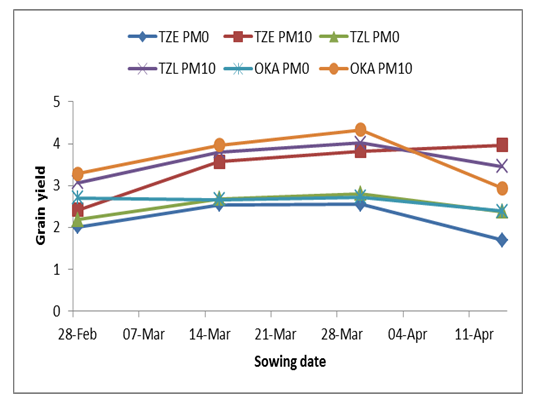 | Figure 3. Grain Yield of Maize Varieties in Response to Poultry Manure across Sowing Dates |
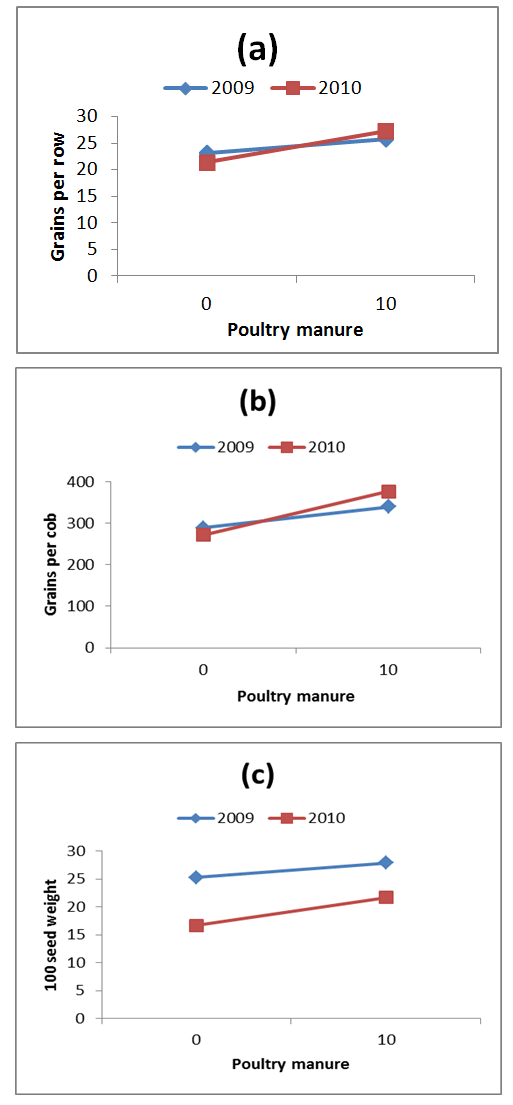 | Figure 4. Effect of Year x Poultry Manure Interaction on Number of Grains Row-1 (a), Number of Grains Cob-1 (b) and 100 Seed Weight (c) |
3.5. Responses among Maize Varieties
- Among the maize varieties, there were significant differences (p = 0.019) in grain yield and highly significant differences (p = 0.001) in number of grain rows cob-1, number of grains row-1, number of grains cob-1 and 100 seed weight (Table 1). The variety, OKA AWAKA, had significantly more grain rows cob-1 (13.9), number of grains row-1 (25.9) and number of grains cob-1 (361.6) than other varieties. While grain yield in OKA AWAKA (3.12 tons/ha) and TZL COMP4 C3 (3.05 tons/ha) were not significantly different, yield was significantly lower in TZE COMP3 C3 (2.82 tons/ha). Table 3 shows that the number of grains row-1, 100 seed weight and grain yield were significantly greater in TZL COMP4 C3 compared to TZE COMP3 C3. The 100 seed weight was also significantly greater in TZL COMP4 C3 compared to OKA AWAKA (Table 3). Generally, TZL COMP4 C3 and OKA AWAKA which are late maturing varieties, were superior to TZE COMP3 C3 (early maturing) in almost all yield components. The superiority of late maturing varieties over early maturing varieties of maize [44], may be due to the fact that the late maturing varieties had more time than the early maturing variety to recover from the effect of the stress [45,46].
|
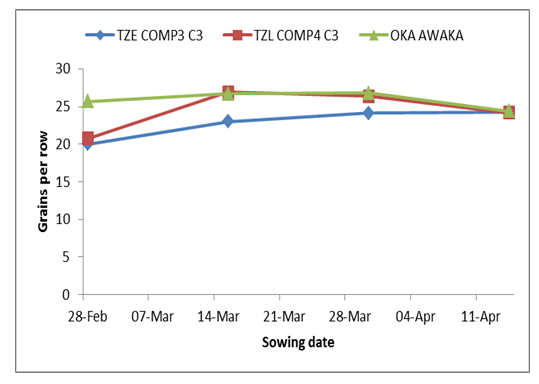 | Figure 5. Effect of Sowing Date x Variety Interaction on Number of Grains Row-1 |
 | Figure 6. Effect of year x sowing date x variety interaction on grain yield |
4. Conclusions
- Climate change manifests in the southeast humid region of Nigeria as delayed onset of rainfall by causing a shift in the long established rainfall pattern in February and March. This leads to moisture stress which previously was not experienced in the region. As a result, farmers in the region are confronted with the challenge of choosing an appropriate time of planting. From this study, under the rain fed cropping systems in the region, 30th of March is recommended as time of planting for maize. In addition, application of poultry manure is recommended because it reduces the impact of moisture stress on rain fed maize. Planting of late maturing maize varieties as against early maturing varieties is also recommended. Therefore appropriate time of planting, application of poultry manure and varietal selection are effective strategies for adaptation to delayed onset of rainfall in the humid region of Nigeria. The findings from this study, though based on 2009 and 2010 field data are still relevant as climate change continues to increase in severity. In Nigeria, delayed onset of rainfall has been on for over a decade and this study was an attempt to understand its implication for crop production. It is expected that the results from this study will be useful to researchers with interest in climate change adaptation studies in the humid tropics in general and the Nigerian rainforest agroecology in particular.
 Abstract
Abstract Reference
Reference Full-Text PDF
Full-Text PDF Full-text HTML
Full-text HTML